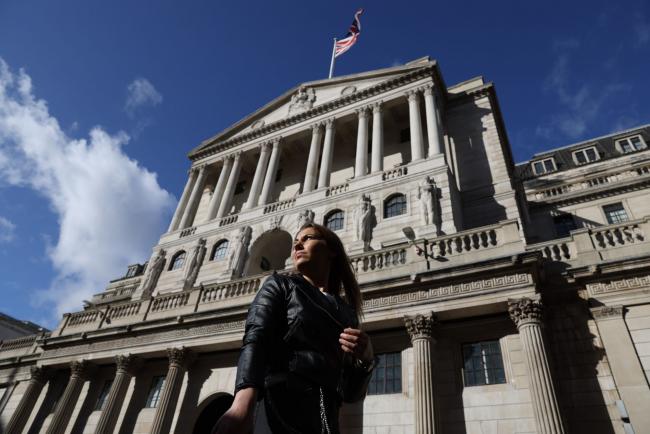(Bloomberg) -- Sign up for the New Economy Daily newsletter, follow us @economics and subscribe to our podcast.
The Bank of England defied market expectations by keeping interest rates on hold, putting concerns about slowing growth above predictions for a spike in inflation.Policy makers led by Governor Andrew Bailey voted 7-2 to keep the benchmark lending rate at 0.1%, and 6-3 to maintain their bond buying target.
Officials also pushed back against market pricing for a series of hikes to 1% next year, noting that path would leave inflation below target at the end of their forecast period.
The central bank nonetheless said recent economic data reinforce the view that borrowing costs will have to rise in the “coming months” to keep inflation on target. Still, it also noted that major uncertainties remain about the jobs market after the end of the government’s furlough program for those out of work during the pandemic.
The decision is likely to raise questions about the credibility of the bank and especially Bailey, who allowed speculation for an immediate move in rates to build in the past few weeks. After warning about “hard yards” faced by the economy as recently as Sept. 27, Bailey since has focused his remarks about unexpected increases in inflation and the need to control price pressures.
Those remarks had led investors to fully price in rate rise this month, although economists divided almost equally on the likelihood of a move. During a similar episode years ago, Bailey’s predecessor Mark Carney was branded the “unreliable boyfriend,” and the current Governor’s decision to vote for a hold may reawaken that criticism.
Policy makers also updated forecasts for the economy, cutting the outlook for growth and increasing it for inflation.Consumer price inflation is now expected to reach 5% in April 2022, the highest forecast since 2011. Most officials judged that to be temporary, and the BOE emphasized that there’s was little monetary policy could do to prevent the spike.
Officials indicated increasing concerns about the outlook for growth, noting signs that consumption is weakening because of supply-side bottlenecks and a surge in the cost of oil, natural gas and electricity.
The committee noted that those issues were holding back the economy, which will linger below its pre-coronavirus level until the first three months of next year, a quarter later than the bank previously expected.
The median estimate for 2022 growth was cut to 5% from 5.3%. That cut came despite a small boost coming from the Treasury after Chancellor of the Exchequer Rishi Sunak lifted spending in his annual budget last week.
Just two officials, Dave Ramsden and Michael Saunders, voted for an immediate move. They noted inflation is likely to remain above target for the next few years unless rates rise. Acting now might reduce the need for a more abrupt tightening later, they said.
Those two, along with Catherine Mann, also voted to reduce the BOE’s target for government bond purchases by 20 billion pounds to 855 billion pounds. Those purchases are due to finish by the end of the year.
The majority saw merit in waiting, saying there was a cost to acting immediately. The current stance of monetary policy allows more space to tighten than loosen, they said.
Expectations about the decision for this meeting shifted rapidly in the past few weeks. Just two months ago, a rate rise this year was all but unthinkable. The BOE opened the door to earlier action at its September meeting and followed that with a series of comments from Bailey highlighting the hawkish case. Those culminated in October with a comment suggesting action was imminent.
That left traders before the meeting pricing in a boost in the benchmark rate to 1.25% by the end of next year. A move of that scale suggests a rate rise once a quarter, which, coupled with the impact on the BOE’s bond holdings, would imply the fastest tightening cycle in at least two decades.
The BOE’s forecasts are conditioned on an older market curve showing rates hitting 1% by the end of 2022. That showed inflation dropping below target by the end of the forecast period, and likely to fall further afterwards. Together, those are signs that officials think that forward curve for rates in financial markets is too aggressive.
Policy makers also cautioned that if energy prices move in line with a downward sloping futures curve, inflation may drop even further below target.
Even without a hike on Thursday, the prospect of a move in coming months leaves the BOE far further down the road to tightening than its major peers.
Federal Reserve Chair Jerome Powell yesterday said won’t entertain interest-rate increases until the labor market heals further, even as the Federal Open Market Committee announced it would start slowing its monthly asset purchases.
Earlier, European Central Bank president Christine Lagarde had indicated she thought the conditions for a rate hike by her institution are unlikely to be met in 2022.
©2021 Bloomberg L.P.
